The industry is in the beginning stages of a great transformation created by digital influences within healthcare. Although many companies are only starting to consider the implications of the digital environment on their business models, several reports state that by 2020, digital will be embedded in most business organizations in the life sciences. According to a global survey conducted by Arthur D. Little and the Karlsruher Institute of Technology, 13% of study participants believe a digital business model is crucial today, and 84% consider it crucial to have a digital strategy in place by 2020. This shift has started in a piecemeal fashion, with companies creating digital solutions — mostly driven by the commercial teams — to solve one problem at a time.
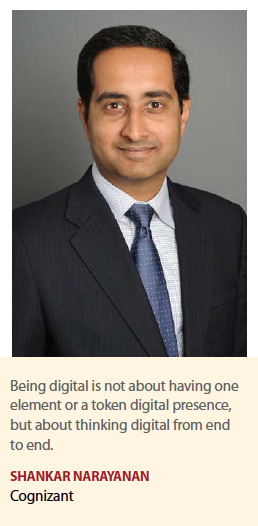 However, the day is coming when companies will need to step back and take a broader view of digitizing their business functions in order to survive and design entirely new models.
However, the day is coming when companies will need to step back and take a broader view of digitizing their business functions in order to survive and design entirely new models.
According to an Accenture report, the industry must embrace digital holistically to improve patients’ quality of life and capture the more than $100 billion of commercial value in the United States in the next five years. Digital expertise is becoming a potent differentiator in the industry, the report says, enabling companies to deliver innovative treatments and services that provide benefits for all the players in the healthcare ecosystem: themselves, payers, providers, and healthcare professionals.
Currently, most companies are taking a characteristic wait-and-see approach to creating wider reaching digital capabilities within their business operations, but the technology is ready, and waiting to implement long-term solutions due to a low tolerance for risk may not be the way to go on this one.
“Many companies at the strategic board level are trying to determine when will be the best time to act," says Drew Schiller, chief technology officer and co-founder of Validic, a cloud-based technology platform for connectivity and access to digital health data. “Many people are waiting for others to take the first step, but there’s a huge opportunity to use digital to advance healthcare, and until we all collectively start taking a step, we’re failing as an industry. We’re not waiting on the technology. We’re waiting for the business decision to move forward and put digital technology into use on a regular basis."
Despite the industry’s hesitation, adoption of technology platforms is slowly increasing. This year will see a revolution in what it really means to be data-driven, and organizations that will thrive will be those that have the platform and technologies to deliver and share information on-demand, anytime, anywhere across the enterprise, says Ramon Chen, chief marketing officer, Reltio, an enterprise data-driven applications and data management company.
“There is good traction because people are realizing that there are three factors that have to be in one system: reliable data, relevant insights, and recommended actions delivered straight to business users," he says.
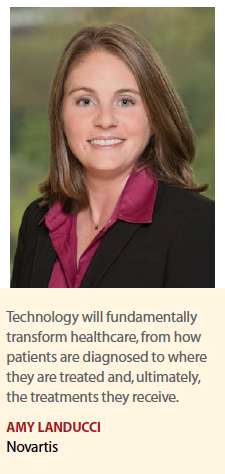 With the increasing popularity of the cloud, smaller companies, many pre-commercial, can now benefit from continuously clean data that not only contains accurate profile information, but deep affiliation, hierarchy, and relationship details.
With the increasing popularity of the cloud, smaller companies, many pre-commercial, can now benefit from continuously clean data that not only contains accurate profile information, but deep affiliation, hierarchy, and relationship details.
Gaining this level of insight used to be purely an IT discipline costing millions in hardware, on premise software, and consulting services.
“Today’s modern data management in the cloud can easily combine and clean master data across internal and external sources, correlate those profiles with transactions, big data or small, and maintain those relationships to provide a core repository from which predictive analytics can be obtained," Mr. Chen says.
At Novartis, the company predicts digital technology will continue to shape a new dynamic in the industry and it is focusing on implementing solutions within the company.
“We believe that technology will fundamentally transform healthcare, from how patients are diagnosed to where they are treated and, ultimately, the treatments they receive," says Amy Landucci, global head, digital medicines, Novartis.
“Increasingly doctors and patients will leverage technology to monitor disease progression at home with a focus on helping patients change their behaviors to live a healthier life. We will also see a significant increase in the use of data and algorithms to identify and diagnose illnesses earlier, while also using data to identify the right medication for an individual’s unique pathology. These advances will make it possible to match the right drug to the right patient at the right time to drive the best possible outcomes."
Taking Action: From Doing Digital to Being Digital
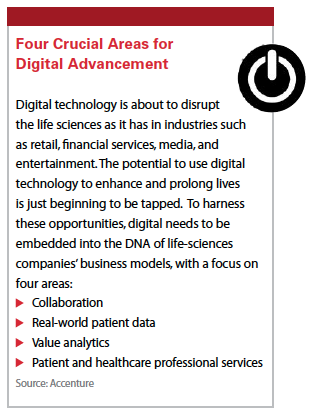 Before industry leaders can fully implement the possibilities of an integrated digital model, they will have to realize that using digital components is not the same as having a digital enterprise.
Before industry leaders can fully implement the possibilities of an integrated digital model, they will have to realize that using digital components is not the same as having a digital enterprise.
“The biggest change the industry needs to make is to first shift its mindset from doing digital to being digital," says Shankar Narayanan, global head of life sciences, Cognizant. “Only then can it move toward actions and behavior changes."
For example, many companies have been using multi-channel marketing, or using mobile apps to recruit patients to a clinical trial, he says. But these are point solutions that are symptomatic of an industry when it’s in the “doing" digital phase.
“Being digital allows a company to say to a patient, you’re now in complete control of your experience and support is all being provided digitally," Mr. Narayanan says.
This will happen when a company broadens its focus beyond one-off solutions, and instead begins to think about how to apply digital thinking over the entire patient journey or product lifecycle.
“This is not just about one element or just having a token digital presence; it’s really about thinking digital end to end," Mr. Narayanan says.
Mr. Schiller agrees that there needs to be a paradigm shift within pharmaceutical companies to embrace available technologies.
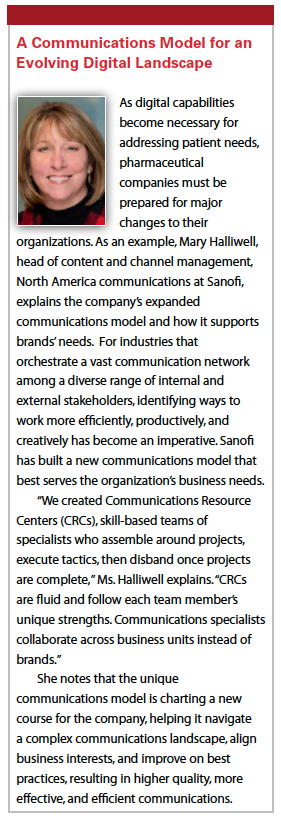 “The big challenge for pharma companies and CROs is they need to think like technology companies," Mr. Schiller says. “They need to be willing to be undeterred by failure, which is not something that is traditional in the clinical trials or research space."
“The big challenge for pharma companies and CROs is they need to think like technology companies," Mr. Schiller says. “They need to be willing to be undeterred by failure, which is not something that is traditional in the clinical trials or research space."
For example, technology can aid in recruitment, the collection of data, and the retention of trial participants, however, the first time a company conducts an AB test on a new way of collecting data versus the old way, the results may not be indicative of the potential within the technology-driven model.
“Chances are that the first digital approaches that companies can try in clinical trials might not be perfect or effective," Mr. Schiller says. “Technology giants such as Google and Apple fail at new products all the time.
“If one thinks about the promise of technology in general, it’s always going to make things more efficient and reduce the cost," he continues. “And if pharma companies are willing to tolerate some risk, digital strategies will pay dividends for the entire industry."
Additionally, the industry needs to invest in this transformation seriously from both a time and budget perspective, says Forrest King, chief innovation officer, Juice Pharma Worldwide.
“The industry must first understand that this shift means doing digital in a new, modern way, and legacy systems and processes, especially IT, legal, and regulatory, don’t work at the pace of business today," he says. “IT, legal, and regulatory teams need to be at the planning table from the beginning and throughout the course of building new ways to work and creating solutions that serve the customer and patient with modern experiences that they have come to expect in our digital-saturated culture."
The pharma industry’s goal should be to speed processes by using technologies to provide data and interaction much like LinkedIn, Facebook, and other social media applications do, Mr. Chen says.
“LinkedIn is a consumer example of where the pharma industry needs to be, especially since today’s social media technologies have changed how people interact with data, and they have grown to expect that data are always available to them," he says.
This means abandoning old legacy systems that take years to build, what McKinsey calls “disrupting beliefs." In this disruptive age, all established business models are under attack, not just the pharma industry. Business models are subject to rapid displacement, disruption, and, in extreme cases, outright destruction, McKinsey reports. Old governing beliefs reflect once widely shared notions about customer preferences, the role of technology, regulation, cost drivers, and the basis of competition and differentiation, but this is all on the verge of a big change.
Core businesses are being built on digital today, Mr. King says. Businesses that languish in legacy operations and outlooks will no longer be viable competitors in the marketplace.
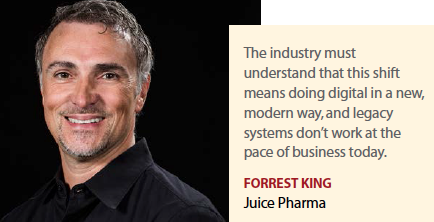 “There are big pharma companies using digital technologies and processes that are antiquated, many more than 10 years old," he says. “They are working in a static digital environment instead of taking the leap and creating a living digital environment. Using data to find and serve customers isn’t the cherry on top; it’s the ice cream itself."
“There are big pharma companies using digital technologies and processes that are antiquated, many more than 10 years old," he says. “They are working in a static digital environment instead of taking the leap and creating a living digital environment. Using data to find and serve customers isn’t the cherry on top; it’s the ice cream itself."
On the commercial side, as data intelligence continues to grow, it will need to be applied to digital marketing strategies. Pharma companies can work with partners to gain real-time key insights on their targets’ behaviors and leverage years worth of behavioral data across millions of digital touchpoints, including mobile networks, to inform engagement strategies and deliver demonstrable improved results, says Brian Robinson, chief marketing and strategy officer, Aptus Health.
On top of that, the world continues to shrink; pharma marketers will need cost-effective, quick-to-market, and above all, integrated, digital engagement strategies aimed at a global audience. They’ll also need to change the way they define and measure engagement, shifting focus from the number of eyeballs on their campaigns to the impact their integrated digital campaigns have on their targets’ attitudes and behaviors.
And finally, Mr. Robinson says, things need to happen quickly; the blistering pace of the digital world means that people expect the info they need to be at their fingertips.
“The good news is that pharma companies can start preparing for the future now, with proven engagement strategies that position themselves as a value-added partner today, five years from now, and even 10 years from now," he says.
Transformation Drivers
Patients, caregivers, and HCPs alike are all immersed in a culture of digital user experiences: user experiences are getting more sophisticated, smarter, and friendlier all the time. Healthcare experiences are being judged based on digital experiences at home, on mobile, at the point-of-sale, and everywhere else a screen pops up in our lives.
“The missteps of the early days of healthcare reform, the launch of healthcare.gov in particular, had President Obama making the point on national television that user experience matters and creating a positive experience would be tied to the success of the program," Mr. King says. “Retail medicine is at the forefront of reimagining the healthcare consumer’s experience. Retail medicine is getting rave reviews from healthcare customers looking for a better healthcare experience."
 Another driver is today’s patients and their behavior; industry must keep pace with the new type of patient who knows more and has more choice in his or her healthcare decisions.
Another driver is today’s patients and their behavior; industry must keep pace with the new type of patient who knows more and has more choice in his or her healthcare decisions.
“Patients are now healthcare consumers, not patients," Mr. King says. “They are consumers of healthcare, more responsible for their own health than ever before in the modern world."
Healthcare consumers demand more from healthcare services today than in history. And because of the wealth of choices that modern healthcare offers and how much every choice costs, healthcare consumers are making decisions with more scrutiny than ever.
“Outcomes matter more than ever, they represent the quality of the investment; they are the soundness of the healthcare financial choices we make every day," he says.
Outcomes based medicine is also another prominent reason for the industry to embrace digital-enabled business models. Although the industry is dipping its toes in by piloting digital in clinical trials, Mr. Schiller says the industry needs to take more action.
“There’s a lot of work being done especially in the clinical trial stage with wearable devices and other digital health strategies in the pre-trial research around patient communities, because it’s very low risk," Mr. Schiller says. “Everyone knows that outcomes-based medicine is the future, and there are really interesting advances that we can leverage in digital health, but for progress to occur the actual work needs to begin now."
Healthcare value is really beginning to play a big role in the outcomes-based world and pharma companies need to prove that therapies actually deliver what they promise.
“Gathering such proof requires the ability to completely close the loop with the patient and be able to track that he or she received the treatment as they’re supposed to," Mr. Narayanan says. “The ability to close the loop is fundamental now, and digital in its various forms is definitely enabling this, and in turn is being accelerated by the push toward outcomes-based and value-based care."
This means pharmaceutical companies need the ability to secure data from real-world evidence and use data to understand the benefits as well as the adverse events and side effects that a treatment causes.
The next step is to implement analytical capabilities that can close the loop with the payers and the PBMs around demonstrating the value of care.
Another factor driving adoption of digital technologies and business models is that today’s newer therapies require more interaction between patients and physicians, and more real-time monitoring. Gone are the days of large primary care therapies that started with simple oral treatment. Today’s increasing numbers of injectable treatments demand much more engaged participation of the patient in the overall healthcare delivery itself, Mr. Narayanan says.
“If we look at all of the newer age therapies, getting the treatment administered itself is a major process, and I think this alone necessitates certain improvements and enhancements to the journey that are very conducive to being digital," he says.
The industry can glean great opportunities from a digitally enabled business model, especially if it embraces the ability of the cloud, as long as the data that are being collected are reliable and accurate. Mr. Chen notes that this has to be the No. 1 priority of a digital system.
“Reliable data have to be the foundation and more often than not people tend to make that an afterthought because it’s not really sexy," he says.
In past years, it was very expensive to get reliable information together and only the very largest pharma companies could afford it.
“Today with the cloud and with the new technologies that are available, even the smallest companies without an IT department can get reliable data through platforms in the cloud," Mr. Chen says.
Second in importance when building a system, he says, is making sure that relevant insights can be distilled down to the individual or there is no ground gained by going with digital.
“It doesn’t matter how much companies spend on business intelligence tools and analytics, if the data have no value to the salesperson or the marketing person," Mr. Chen explains.
A third step that will emerge in the future is the ability to provide decision-making tools, much like Amazon does when a consumer makes a purchase and recommendations are provided for other items that might be of interest.
“This capability is not available in pharma systems yet, but it should be," Mr. Chen says. (PV)


















